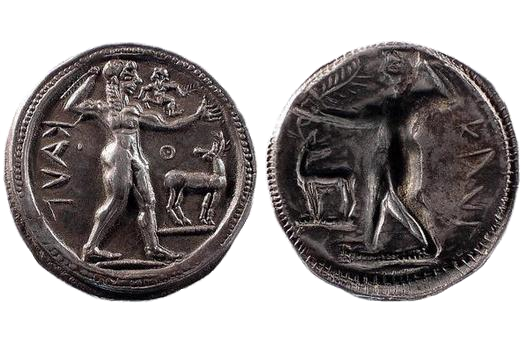
about ancient nomos
Ancient Nomos Art is a museum of galleries exhibiting ancient coins and ancient mint maps. The coin gallery displays the diverse art and history of hand-crafted ancient Greek, Roman, Byzantine, Persian and Medieval coinage. The ancient mints mapping gallery features Greek, Roman, Byzantine, Asia Minor and Medieval mint city regions and territories. Visitor's are welcome to explore, study and enjoy Ancient Nomos Art.

Greek, Bruttium – 525 BC
Kaulonia
From Ancient Galleries

Obverse: Nude Apollo, diademed with hair in long ringlets, standing right.
Reverse: Incuse Apollo and stag to the left with ethnic inscription to the right.
LEGEND and SYMBOLISM
Obv. Nude Apollo standing right on dotted line, holding branch in right hand; on his extended left arm, small running figure with winged feet carrying branch with head turned backwards; stag with head turned backward on dotted line; theta in field to right; ethnic inscription KAVL behind; whole in dotted border between two circles. Rev. Incuse Apollo standing left holding branch; stag in field to left; inverted ethnic KAVL to right; whole in dentate incuse border.
This coin was struck in the ancient Achaean city of Kaulonia, on the east coast of Bruttium (southern Italy). This very remarkable coin type has elicited many interpretations regarding its symbolic meanings. Some believe that the branch in Apollo’s right hand symbolizes a kind of purification or blessing of the city. Others believe that Kaulonia is associated with more humble origins, as symbolized by the Kaulos plant. The vegetable roots (Pastinaca Sativa) have been cultivated since ancient times as a valuable esculent, or edible plant. More noble interpretations ascribe the local plant to the god Apollo as a heroic emblem, as the celery leaf became the emblem of the eponymous hero of Selinos (see Selinos didrachm). Yet another interpretation of this coin is that the figure of Apollo represents the mythical city founder, holding in his raised branch of laurel to crown himself. A small figure is seen on his left arm, running with winged feet, and also holding the same branch in each of his hands. Some suggest this is the wind-god Zephyros, running on his left arm as messenger announcing Apollo’s arrival. Or that Zephyros is using west winds to cleanse the air and laurels to purify. Others suggest the small figure was intended as the personification of Hermes with stag, as described by the poet Hyginus. On numerous specimens the stag is accompanied by a stalk or shoot of the Kaulos plant springing from the ground. The sacred stag along side Apollo has often been regarded as the actual emblem of Kaulonia. This is perhaps the earliest depiction of the mythological stag shown accompanying Apollo into what is known as the fertile valleys of Kaulonia.
SPECIAL FEATURE EXHIBIT
The ANAM Special Features gallery demonstrates how the Auction Archives Library at the Newman Numismatic Portal (Newman Portal Link) discovered the ancient Kaulonia auction catalog provenance, one of the largest online repositories of numismatic information in the world. To view the Special Features Kaulonia Hirsch archives post, please use the following link: Kaulonia Hirsch Archives Exhibit
DOCUMENTATION
Value: Stater. Metal: AR Silver. Weight: 7.99 grams. Mint: Bruttium, Kaulonia. Date: 510-490 BC.
Attribution: S. P. Noe, Coinage of Caulonia, ANS NS 9, 1958, 30a (this coin); J. Hirsch, 1911, 268 (this coin); Weber, Plate 38 (without theta & reverse ethnic).
Legend, Documentation and Attribution
